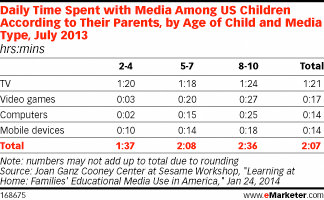Kids Still Spend the Most Time with TV
June 6, 2014
![]() When people speak of “digital kids,” the novelty of the adjective may obscure the importance of the noun. Above all, kids—those ages 12 or younger—are still just kids. Their engagement with technology is limited by the immature interests and capabilities that go with being very young, and further limited by restrictions their parents impose. In important respects, kids are digital natives who aren’t all that digital, according to a new eMarketer report, “Digital Kids: ‘Digital Natives’ with Analog Tendencies.”
When people speak of “digital kids,” the novelty of the adjective may obscure the importance of the noun. Above all, kids—those ages 12 or younger—are still just kids. Their engagement with technology is limited by the immature interests and capabilities that go with being very young, and further limited by restrictions their parents impose. In important respects, kids are digital natives who aren’t all that digital, according to a new eMarketer report, “Digital Kids: ‘Digital Natives’ with Analog Tendencies.”
 TV remains the biggest single element of kids’ media usage. For adults, TV may be old media. For kids, it’s fun media—the place where they see the cartoons and other shows that delight them. And for many kids, the older networks are supplemented by digital sources.
TV remains the biggest single element of kids’ media usage. For adults, TV may be old media. For kids, it’s fun media—the place where they see the cartoons and other shows that delight them. And for many kids, the older networks are supplemented by digital sources.
In its tabulation of media usage during Q4 2013, Nielsen found that kids ages 2 to 11 watched 111 hours 10 minutes of “traditional TV” per month. In addition, they spent 10 hours 45 minutes watching timeshifted TV. Further, the kids used a DVD/Blu-ray device to view content for 9 hours 18 minutes.
Inquiring about a different mix of media activities, July 2013 polling by the Joan Ganz Cooney Center at Sesame Workshop got a lower figure from parents for daily viewing among their 2- to 10-year-olds. Still, TV was the dominant medium.
Still, the proliferation of devices has encroached on TV time. Common Sense Media found a decline between 2011 and 2013—65% to 58%—in the proportion of kids who watched TV as an everyday activity. There was also a decline in everyday DVD viewers, from 25% to 18%. By contrast, the proportion using mobile devices every day more than doubled during that time, from 8% to 17%.
Much of the kid content on conventional TV is available via streaming services, along with those sites’ original programming. In addition to letting kids get what they want on their own schedule, an option like Netflix appeals to parents because kids won’t be inundated with commercials.
In a February 2014 paper summarizing a recent “TV Network Report” by children’s market research and consultancy Smarty Pants, the firm’s trends and insights guru Melanie Shreffler wrote: “From a kid’s point of view, Netflix and YouTube are one-stop shops for all their video needs.”
Streaming is also well suited to kids’ repetitive viewing. As parents know—often to their despair—young children can enjoy watching a favorite episode of a show over and over. A November 2013 article from The New York Times said of kids: “Instead of binge viewing as their parents do, they ‘déjà view.’” It noted a finding by Amazon that “65% of the most replayed programs on its streaming service, Prime Instant Video, are shows for children.”
More broadly, streaming meets the expectation kids have grown up with for getting the content they want when they want it. “They are absolutely accustomed to the idea of on-demand,” said Marjorie Cohn, head of television at DreamWorks Animation, which is developing original programming for Netflix.
Courtesy of eMarketer





























